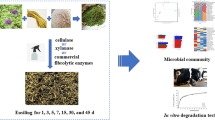Summary
Wheat straw (WS) was treated with 5% sodium hydroxide, ozone and 5% sulfur dioxide at 70°C for 72 h, and the effect of treatments on monosaccharide composition and in vitro degradability by rumen microorganisms was studied. The major sugars, glucose and xylose, comprising about 90% of the total monosaccharides in the untreated WS were mainly confined to the cell walls. SO2 exerted the greatest solubilizing effect, followed by ozone and NaOH; the respective values for the solubilized cell wall polysaccharides were: 26, 12 and 4.4%. One third of the total phenolics was oxidized by ozone, whereas, SO2 exerted mostly a solubilizing effect on this fraction, converting 75% of it into soluble phenolics. In the NaOH treated WS 41% of the total phenolics were soluble, as compared to 22% in the untreated. The in vitro digestibility of monosaccharides in the untreated WS were initially high: 50% and 58% for xylose and glucose, respectively and 63% to 80% for the minor sugars. The SO2 treatment resulted in an overall increase in digestibility of monosaccharides with values lying in the range of 90%. Sodium hydroxide was more efficient than ozone in enhancing the degradability of xylan and total sugars. The digestibility of cell wall sugars was increased from 52.4% to 84.4%, 63.4% and 72.3% by SO2, O3 and NaOH treatments respectively. Based on the present findings, it appears that wheat straw cell wall components are more sensitive to hydrolytic than to oxidative processes aimed at increasing its degradability by rumen microorganisms. SO2 exerted on WS a multi-effect which was particularly suitable for increasing the digestibility of monosaccharides.
Similar content being viewed by others
References
Bacon JSD, Chesson A, Gordon AH (1981) Deacetylation and enhancement of digestibility. Agric Environ 6:115–126
Bacon JSD, Gordon AH (1980) The effects of various deacetylation procedures on the nylon bag digestibility of barley straw and grass cell walls recovered from sheep faeces. J Agric Sci Camb 94:361–367
Bailey RW (1973) Structural carbohydrates. In: Butler GW, Bailey W (eds) Chemistry and biochemistry of Herbage. Academic Press, New York, pp 157–209
Ben-Ghedalia D, Miron J (1981) Effect of sodium hydroxide, ozone and sulphur dioxide on the composition and in vitro digestibility of wheat straw. J Sci Food Agric 32:224–228
Ben-Ghedalia D, Shefet G, Miron J (1980) Effect of ozone and ammonium hydroxide treatments on the composition and in vitro digestibility of cotton straw. J Sci Food Agric 31:1337–1342
Ben-Ghedalia D, Shefet G, Miron J, Dror Y (1982) Effect of ozone and sodium hydroxide treatments on some chemical characteristics of cotton straw. J Sci Food Agric (in press)
Binder A, Pelloni L, Fiechter A (1980) Delignification of straw with ozone to enhance biodegradability. Eur J Appl Microbiol Biotechnol 11:1–5
Blumenkrantz A, Asboe-Hansen G (1973) New method for quantitative determination of uronic acids. Anal Biochem 54:484–489
Chesson A (1981) Effects of sodium hydroxide on cereal straws in relation to the enhanced degradation of structural polysaccharides by rumen microorganisms. J Sci Food Agric 32:745–758
Crawford D, Crawford R (1980) Microbial degradation of lignin. Enzyme Microbiol Technol 2:11–22
Eggeling L, Sahm H (1981) Degradation of Lignin-related aromatic compounds by nocardia spec DSM 1069 and specificity of demethylation. In: Schaal, Pulverer (eds) Actinomycetes, Suppl 11. Gustav Fischer, Stuttgart New York, p 361–365
Forss K, Fremer K, Stenlund B (1966) Spruce lignin and its reactions in sulfite cooking I. The structure of lignin II. The reactions in sulfite cooking. Paper and Timber 48:I, 565–574; II, 669–671
Goering HK, Van Soest PJ (1970) Forage fiber analysis. USDA Agricultural Handbook No. 379
Hartley RD (1973) Carbohydrate esters of ferulic acid as components of cell-walls of Lolium multiflorum. Phytochemistry 12:661–665
Higuchi T, Ito Y, Shimada M, Kawamura I (1967) Chemical properties of milled wood lignin of grasses. Phytochemistry 6: 1551–1556
Millet MA, Baker AJ, Satter CD (1976) Physical and chemical pretreatment for enhancing cellulose saccharification. Biotechnol & Bioeng Symp 6:125–153
Morrison IM (1972) A semi-micro method for determination of lignin and its use in predicting the digestibility of forage crops. J Sci Food Agric 23:455–463
Morrsion IM (1974) Structural investigations on the lignin-carbohydrate complexes of Lolium perenne. Biochem J 139:197–204
Miron J, Ben-Ghedalia D (1981) Effect of chemical treatments on the degradability of cotton straw by rumen microorganisms and by fungal cellulase. Biotechnol Bioeng 23:1427–1437
Sarkanen KV (1981) Principles and practical approaches to chemical and hydrothermal delignification. In: Domsch KH, Ferranti MP, Theander O (eds) Improved Utilization of Lignocellulosic Materials for Animal Feed. OECD/COST workshop. Braunschweig, pp 19–35
Sloneker JH (1972) Gas liquid chromatography of alditol acetates. In: Whistler RL, BeMiller JN (eds) Methods in Carbohydrate Chemistry. Academic Press, New York London, p 20–24
Sneddon DN, Thomas VM, Roffler RE, Murray G (1981) Laboratory investigations of hydroxide-treated sunflower or alfalfa-grass silage. J Anim Sci 53:1623–1628
Theander O, Aman P (1980) Chemical composition of some forages and various residues from feeding value determinations. J Sci Food Agric 31:31–37
Tilley JM, Terry RA (1963) A two-stage technique for the in vitro digestion of forage crops. J Brit Grassland Soc 18:104–111
Vered Y, Milstein O, Flowers HM, Gressel J (1981) Biodegradation of wheat straw lignocarbohydrate complexes (LCC) I. Dynamics of liberation of hot aqueous LCC's from wheat straw and partial characterization of the products. Eur J Appl Microbiol Biotechnol 12:183–188
Author information
Authors and Affiliations
Rights and permissions
About this article
Cite this article
Miron, J., Ben-Ghedalia, D. Effect of hydrolysing and oxidizing agents on the composition and degradation of wheat straw monosaccharides. European J. Appl. Microbiol. Biotechnol. 15, 83–87 (1982). https://doi.org/10.1007/BF00499511
Received:
Issue Date:
DOI: https://doi.org/10.1007/BF00499511




